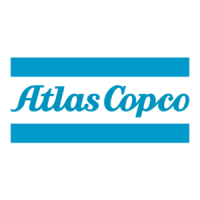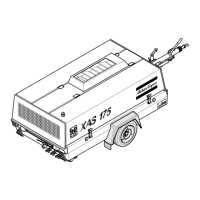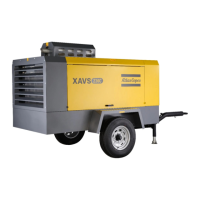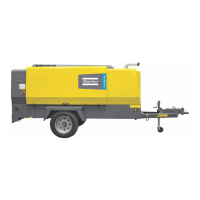6 1310 3011 73
one to the eye provided next to the compressor air
outlet valve, the other one to a point near to the air
inlet of the applied equipment.
Finally a wire mesh hose can be fixed over the hose
ends to dampen the blast in case a connection starts
leaking or should become undone.
Close the compressor air outlet valve before
connecting or disconnecting a hose. Ascertain that a
hose is fully depressurized before disconnecting it.
When blowing through a hose or air line, ensure that
the open end is held securely. A free end will whip
and may cause injury.
Never play with compressed air. Never apply it to your
skin or direct an air stream at people. Never use it to
clean dirt from your clothes. When using it to clean
down equipment, do so with extreme caution and use
eye protection.
11 Never move a unit when external lines or hoses are
connected to the outlet valves, to avoid damage to
valves and/or manifold and hoses.
12 Never refill fuel while the unit is running. Keep fuel
away from hot parts such as air outlet pipes or the
engine exhaust. Do not smoke when fueling. When
fueling from an automatic pump, a ground cable
should be connected to the unit to discharge static
electricity. Never spill nor leave oil, fuel, coolant or
cleansing agent in or around the unit.
13 Never operate the unit in surroundings where there is
a possibility of taking in flammable or toxic fumes.
14 Never operate the unit at pressures or speeds below
or in excess of the limit ratings stated on the Principal
Data sheet.
15 On water-cooled engines with closed cooling circuit:
allow the unit to cool before removing a pressure cap.
16 All doors shall be shut during operation so as not to
disturb the cooling air flow inside the body-work and/or
render the silencing less effective. A door should be
kept open for a short period only, e.g. for inspection or
adjustment
17 Wear ear protectors when environmental noise can
reach or exceed 85 dB(A). Beware of long-time
exposure to noise.
18 Periodically check that:
- all safety equipment is in good working order,
- all guards and air conducting baffles are in place
and securely fastened,
- all hoses and/or pipes inside the unit are in good
condition, secure and not rubbing,
- there are no fuel, oil or coolant leaks,
- all fasteners are tight
- all electrical leads are secure and in good order,
- the engine exhaust system is in good condition,
- air outlet valves and manifold, hoses, couplings,
etc. are in good repair, free of wear or abuse,
- the wheel nuts are tightened to the proper torque.
When more than one compressor is connected to a common
header, be sure each compressor has a non-return valve (check
valve) to prevent reverse rotation when stopping.
1.4 Safety During Maintenance and Repair
Maintenance and repair work shall only be carried out by
adequately trained personnel: if required, under supervision of
someone qualified for the job.
1 Use only the correct tools for maintenance and repair work.
2 Use only genuine spare parts.
3 All maintenance work, other than routine attention, shall
only be undertaken when the unit is stopped. Ensure that
the unit cannot be started inadvertently.
4 Before removing any pressurized component, effectively
isolate the compressor from all sources of pressure and
relieve the entire system of pressure. Do not rely on non-
return valves (check valves) to isolate pressure systems.
5 Never use flammable solvents or carbon tetrachloride for
cleaning parts. Take safety precautions against toxic
vapors from cleaning liquids.
6 Scrupulously observe cleanliness during maintenance and
when performing repairs. Keep dirt away by covering the
parts and exposed openings with a clean cloth, paper or
tape.
7 Never weld on or perform any operation involving heat near
the fuel or oil systems. Fuel and oil tanks must be
completely purged, e.g. by steam-cleaning, before carrying
out such operations.
Never weld on, or in any way modify, pressure vessels.
Disconnect the alternator cables during arc welding on the
unit.
8 Support the drawbar and the axle securely if working
underneath the unit or when removing a wheel. Do not rely
on jacks.
9 Make sure that no tools, loose parts or rags are left in or on
the unit.
10 Before clearing the unit for use after maintenance or
overhaul, check that operating pressures, temperatures and
speeds are correct and that the control and shutdown
devices function correctly.
11 Do not remove any of, or tamper with, the sound damping
material. Keep the material free of dirt and liquids such as
fuel, oil and cleansing agents.
12 Protect the electrical and regulating components, the air
filter, etc. to prevent moisture from entering them, e.g. when
steam-cleaning.

